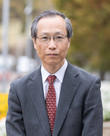On International Funds Flow Statistics
Hiroshi Yutani
Professor, Faculty of Global Management, Chuo University
Area of Specialization: Finance
1. The meaning of researching international funds flows
One year has passed since the first case of COVID-19 was confirmed in Wuhan, China in December 2019. The World Health Organization (WHO) declared a pandemic in around March 2020. From that time, countries throughout the world began to place certain restrictions on the movement of people. Consequently, the movement of people throughout the world decreased sharply in 2020. Furthermore, the impact of these changes caused temporary closure of factories and temporary delay in exports and imports; in other words, in the movement of goods.
In monetary terms, stock prices plummeted starting in March 2020, particularly in the United States. However, there was a fast recovery due to money supplied by central banks in the US and other major countries through accommodative monetary policies. As a result, there was no major decrease throughout the entire year. Recently, negative economic growth is expected in many countries due to lockdowns intended to curb the spread of COVID-19. At the same time, stock prices are rising in countries such as the US, and there is concern about the possibility of divergence from the real economy.
In this way, money sometimes behaves differently from the real economy. This has the potential to adversely affect the real economy. This is clear from the fact that we have experienced numerous financial crises in the past. Moreover, unlike people and goods, money moves easily across national borders. Therefore, it is necessary to pay particular attention to international money--namely, the flow of funds.
2. Data on international funds flows
2.1 Domestic statistics
 Let me briefly examine the movement of people, goods, and money mentioned in the previous section in the case of Japan first. Based on the Statistical Survey on Legal Migrants from the Immigration Services Agency of Japan, Figure 1 compares the total number of migrants between 2019 and 2020. Next, based on the Balance of Payments statistics from the Bank of Japan, Figure 2 compares the total of exports and imports from the trade balance between 2019 and 2020. Finally, also based on the financial account in the aforementioned Balance of Payments, Figure 3 compares the total acquisition amount and disposition amount of portfolio investment on the sides of assets and liabilities between 2019 and 2020. These figures show that the movement of people is decreasing sharply and the movement of goods is also decreasing although not to the extent of that of people. Conversely, the movement of money is increasing.
Let me briefly examine the movement of people, goods, and money mentioned in the previous section in the case of Japan first. Based on the Statistical Survey on Legal Migrants from the Immigration Services Agency of Japan, Figure 1 compares the total number of migrants between 2019 and 2020. Next, based on the Balance of Payments statistics from the Bank of Japan, Figure 2 compares the total of exports and imports from the trade balance between 2019 and 2020. Finally, also based on the financial account in the aforementioned Balance of Payments, Figure 3 compares the total acquisition amount and disposition amount of portfolio investment on the sides of assets and liabilities between 2019 and 2020. These figures show that the movement of people is decreasing sharply and the movement of goods is also decreasing although not to the extent of that of people. Conversely, the movement of money is increasing.
As the data which describe domestic flow of funds, we have the Flow of Funds Accounts. The accounts classify economic entities such as households and companies into seven sectors, and adopt a matrix format to show how much of each financial product (cash and deposits, stocks, etc.) is acquired, disposed, procured, or redeemed. The accounts consist of three tables: Assets and Liabilities Table, which shows the outstanding balance of each financial product at the end of the quarter or the end of the year, Transaction Table, which shows the increase/decrease in the outstanding balance for two periods, and Reconciliation Table, which shows changes in the valuation amount, etc. Since one of the seven sectors is overseas, it is possible to analyze the relationship of the inflow and outflow of funds from overseas with the domestic sectors in Japan.
2.2 Balance of Payments and other related statistics
Balance of Payments record transactions between domestic and foreign countries for a certain period of time. In the statistics, the portion related to the increase and decrease of financial assets and liabilities is the financial account. These are the statistics that record the major international movements of funds of a country. The financial account consists of direct investment, portfolio investment, and other investments. The category of other investments includes loans and trade credits.
The financial account corresponds to the Transaction Table of the Flow of Funds Accounts. The statistics which corresponds to the Assets and Liabilities Table is the International Investment Position (IIP). If we add a reconciliation table between flows and stocks that records fluctuations in valuation amount, etc., aggregate all of the financial account, IIP, and the reconciliation table with respect to all over the world, it would (in theory) create flow-of-funds accounts that show the international movement of funds throughout the world. The Balance of Payments of 199 countries and regions are published by the International Monetary Fund (IMF).
The financial account and the IIP are independent statistics for a single country. Accordingly, these statistics may be sufficient for analyzing the inflow and outflow of external funds for a specific country. However, we sometimes wish to understand cross-country relationships; that is, which country the money is flowing out of and which country the money is flowing into. This may also provide a better understanding of the structure of international funds flows. The Coordinated Direct Investment Survey (CDIS) and Coordinated Portfolio Investment Survey (CPIS) are published by the IMF as statistics focusing on the flow of funds between nations. The definitions of terms are based on the IMF's Balance of Payments and International Investment Position Manual (6th Edition). Therefore, CDIS corresponds to the direct investment of IIP, and CPIS corresponds to the portfolio investment of IIP. The countries and regions covered by each survey are limited. Currently, CDIS reports on 111 countries/regions for inward direct investment positions and 85 countries/regions for outward direct investment positions, while CPIS reports on 82 countries/regions.
2.3 International Banking Statistics
In terms of the flow of funds between nations, CDIS and CPIS correspond to some portions of IIP, not the entirety. In other words, the other investment portion of IIP is an issue. By definition, portfolio investment includes securities that are traded in the market, but does not include assets and liabilities that are not traded in the market, such as loans. In this respect, we can turn to the international banking statistics published by the Bank for International Settlements (BIS); specifically, the International Locational Banking Statistics (LBS) and the International Consolidated Banking Statistics (CBS). These are the statistics on external assets and liabilities by bank account. The former shows the asset/liability relationship between countries where borrower and bank offices are located, while the latter shows the relationship in terms of the risk, namely relationship between countries where borrowers and banks' headquarters are located.
LBS and CBS can be expected to include bank loans and trade credits that are not covered by CPIS. On the other hand, since banks also conduct portfolio investment in the market, they should also include data that overlap with CPIS. Moreover, the relationship between nations changes depending on whether LBS or CBS is used. Therefore, caution must be taken when using LBS and CBS as complementary data to CPIS.
Additionally, the countries and regions for which data can be collected are limited. LBS is currently limited to 48 countries and regions. However, according to BIS, these 48 countries and regions cover 94% of the total.
3. Significance and challenges of cross-country data in international funds flows
International funds flows occur due to a variety of factors. In particular, since portfolio investment simply pursues investment returns, the interest rate differences, exchange rates, tax differences, market openness, etc., among countries immediately come to mind as reasons for funds flows. Moreover, international funds flows are extremely sensitive to risks; therefore, political risks, geopolitical risks, and expectations for economic growth also have an impact on the flows. In turn, this impact may appear in the degree of closeness and power relationships among nations. We can expect to grasp such relationships among nations by analyzing the cross-country flows of funds. In addition, the flow of funds is likened to the bloodstream of the economy. When a financial problem occurred in a certain country or region, it might be used to forecast the countries and regions to which the problems would spread first.
The challenges are timing and coverage. In contrast to the rapid flow of funds, the latest data for CDIS and CPIS are still from the end of 2019 (data for LBS and CBS are from the end of June 2020). The data frequency is annual for CDIS, semi-annual for CPIS, and quarterly for LBS and CBS. Therefore, these statistics are not suitable for ascertaining the current situation, and are mainly used for after-the-fact analysis. The starting years of these statistics are also new; specifically, annual publication for CDIS started in 2009. Annual publication for CPIS started in 2001, and biannual publication in 2013. The number of data is still small for time series analysis. As for coverage, most likely due to political reasons, a number of data are not disclosed in CDIS and CPIS. As a result, the countries and regions that can be analyzed are limited.
Although the numerous issues discussed above exist, it is still possible to obtain certain valuable hints for international finance due to the large amount of data available for use.
Hiroshi Yutani
Professor, Faculty of Global Management, Chuo University
Area of Specialization: FinanceHiroshi Yutani was born in Tokyo in 1960.
In 1983, he graduated from the Faculty of Economics, Keio University.
In 1990, he acquired his MBA at the University of Rochester (United States).
In 2010, he completed the Doctoral Program in the Graduate School of Economics, Chuo University. (PhD in economics).
He served as Professor in the Institute of Business and Accounting, Kwansei Gakuin University from 2012. In 2019, he assumed his current position.
From 1983 to 2012, he worked at a bank and was involved in international finance, internal audits, etc., including the positions in New York and Bangkok.His current research themes are international funds flows and the financial systems of each country.
His main written work includes Thai Finance Systems and Fund Circulation Structure (Sankeisha, 2010).









